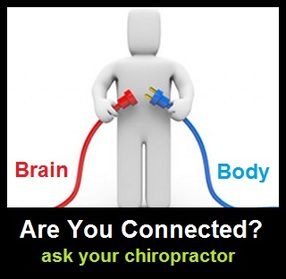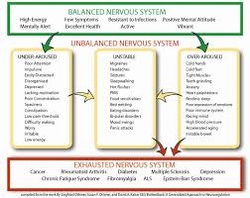What is Neurologically Based Chiropractic?

The Intent of care in our office is to assist our clients on improving their neurological function and obtaining ideal neuroplasticity (the ability of the nervous system to adapt and respond to a stressor and maintain homeostasis/balance).
We know that there are 3 main systems of the body:
The exciting news is our office has the latest technology Neuroscience has to offer that allows us to look at the ability of the nervous system to adapt and respond. You will not find another office that offers this technology unless you want to take a trip to Kansas City or St. Louis. We are pleased to bring this technology to our community and can't wait to see the affects it has on changing lives and offering a greater quality of healthcare.
We know that there are 3 main systems of the body:
- #3 The Passive System=consists of bones and joints. They do nothing on their own! So they are never the cause of dysfunction!
- #2 The Active System=consists of the muscles responsible for actions. They can't act on their own! So they are never the cause of dysfunction!
- #1 The Nervous System=the control system...the central organizing authority. Nothing takes place in our bodies without the Nervous System initiating and approving the process. THE CAUSE OF DYSFUNCTION!
The exciting news is our office has the latest technology Neuroscience has to offer that allows us to look at the ability of the nervous system to adapt and respond. You will not find another office that offers this technology unless you want to take a trip to Kansas City or St. Louis. We are pleased to bring this technology to our community and can't wait to see the affects it has on changing lives and offering a greater quality of healthcare.
What is a Stress Response?

All living creatures have an awareness of a threat to their existence. Humans have a built in warning system that alerts them to all levels of threats. Our 5 senses alert us to danger even when we are totally unaware of it. Bad smells, unusual sounds, foul tastes are just some of these warning systems. The subconscious is even more sensitive and will often trigger a protection response of which we are unaware consciously such as an increase in blood pressure, heart rate or respiration.
The nervous system is divided into two main divisions:
Stress is a threat and even low levels of stress over time can have drastic results in the health of an individual. What many don’t understand is that “STRESS” is a response to a “STRESSOR” and throughout a lifetime we will always be confronting stressors.
The challenge lies in several areas: the intensity of the stressor, the duration of the stressor, the level of previous damage done to the stress response system and the ability of the system to return to a normal balanced state.
As current medical research is now claiming that 95% of all Illnesses are the result of a lack of the body’s ability to reestablish normal balance, it only makes sense that we learn what must be done to bring the body back into correct neurological responses.
As it is critical for good health to have a nervous system which can adapt to stressors and recover correctly....it only makes sense that we have a method which has the ability to measure these action/reactions. It is much easier to keep the system in balance than to attempt to correct it once it has already been damaged.
The nervous system is divided into two main divisions:
- Para-Sympathetic-keeps everything running smoothly and in balance
- Sympathetic- responsible for protection and defense and doesn't care about balance, its only purpose is to offer extreme responses to preserve life.
Stress is a threat and even low levels of stress over time can have drastic results in the health of an individual. What many don’t understand is that “STRESS” is a response to a “STRESSOR” and throughout a lifetime we will always be confronting stressors.
The challenge lies in several areas: the intensity of the stressor, the duration of the stressor, the level of previous damage done to the stress response system and the ability of the system to return to a normal balanced state.
As current medical research is now claiming that 95% of all Illnesses are the result of a lack of the body’s ability to reestablish normal balance, it only makes sense that we learn what must be done to bring the body back into correct neurological responses.
As it is critical for good health to have a nervous system which can adapt to stressors and recover correctly....it only makes sense that we have a method which has the ability to measure these action/reactions. It is much easier to keep the system in balance than to attempt to correct it once it has already been damaged.
NeuroInfiniti Evaluation

The NeuroInfiniti Stress Response Evaluation is an effective and accurate method of measuring your physiological stress response. It is a 12 minute computerized test, a totally non-invasive exam using an instrument found in research facilities around the world. Sensors are attached to your skin in such areas as your shoulder muscles, the top of your head, your forearms, and your hands. From this computerized test, we can compare your neurological response and recovery to stress challenges.
The NeuroInfiniti Measures
Brain Waves- This portion of the exam concerns the ability of the brain to be busy when necessary and to rest when necessary. Stress events like the math test, noises and breathing exercise require brain activity (increased Beta) and when relaxed, increased Alpha/Theta.
Heart Rate Variability- is an effective method of measuring stress effects in your life. Research has established that HRV is also a good method of measuring the effectiveness of Chiropractic care.
Heart Rate- We have long been aware of the importance of heart rate in maintaining good health responses; however, just taking a person's pulse isn't enough information to tell us what happens during stress situations. The stress test gives us a chance to see what speeds up the heart rate, and how quickly it can return to normal. There is a direct relationship between breathing and heart rates.
Skin Conductance- The amount of moisture produced by the sweat glands in the hands is a direct result of stress. More hand moisture means a higher stress response. We can measure your ability to reduce the effects of your stressors. This means improved neurological responses.
Temperature- The normal response to stress is for the body to withdraw blood volume from the extremities and pool it in the organs. This action reduces the temperature in the hands and feet.
Respiration Rate- While we are aware of changes in respiration rate during exertion, we seldom use it as a measurement of health. As there is a relationship between stress and oxygen requirement, the respiratory rate is very important. The pattern of breathing is equally as important such as chest elevation versus diaphragmatic breathing.
Muscle Activity- We can measure muscle activity throughout the body in both relaxed resting mode or in active motion mode. The trapezius and the muscles of the face are good indicators of over-tightened muscles due to stress responses.
Heart Rate Variability- is an effective method of measuring stress effects in your life. Research has established that HRV is also a good method of measuring the effectiveness of Chiropractic care.
Heart Rate- We have long been aware of the importance of heart rate in maintaining good health responses; however, just taking a person's pulse isn't enough information to tell us what happens during stress situations. The stress test gives us a chance to see what speeds up the heart rate, and how quickly it can return to normal. There is a direct relationship between breathing and heart rates.
Skin Conductance- The amount of moisture produced by the sweat glands in the hands is a direct result of stress. More hand moisture means a higher stress response. We can measure your ability to reduce the effects of your stressors. This means improved neurological responses.
Temperature- The normal response to stress is for the body to withdraw blood volume from the extremities and pool it in the organs. This action reduces the temperature in the hands and feet.
Respiration Rate- While we are aware of changes in respiration rate during exertion, we seldom use it as a measurement of health. As there is a relationship between stress and oxygen requirement, the respiratory rate is very important. The pattern of breathing is equally as important such as chest elevation versus diaphragmatic breathing.
Muscle Activity- We can measure muscle activity throughout the body in both relaxed resting mode or in active motion mode. The trapezius and the muscles of the face are good indicators of over-tightened muscles due to stress responses.
How We Use The Results

We use the results of the SRE to identify the state of your nervous system:
Balanced- This type of nervous system will demonstrate signs of: high energy, few symptoms, resistance to infections, positive mental attitude, present time consciousness, mentally alert, excellent health, looks younger than years, remains active and vibrant, etc..
Over-aroused- This type of nervous system will demonstrate signs of cold hands, tight muscles, teeth grinding, anxiety, heart palpitations, restless sleep, poor: social awareness; comprehension; expression of emotional, re-current infections, multiple competing trains of thought, high blood pressure, accelerated aging, irritable bowel, high blood pressure etc.
Under-aroused- This type of nervous system will demonstrate signs of ADD (including impulsivity, distraction, & disorganization), depression, lack of motivation, poor concentration, spaciness, low blood pressure, hypoglycemia, constipation, low pain threshold , difficulty awakening, cognitive worry, irritability, incontinence, lack of energy, etc..
Unstable- This type of nervous system oscillates between under arousal and over arousal, and may demonstrate signs in both over and under aroused plus: migraine headaches, seizure, narcolepsy, sleepwalking, hot flashes, PMS, multiple chemical sensitivities, bed wetting, eating disorders, bi-polar disorder, mood swings, panic attacks, etc..
Exhausted- This type of nervous system may demonstrate signs of all of those listed in over-aroused plus Chronic Fatigue Syndrome, Epstein-Barr Syndrome, M.S., ALS, RA, Fibromyalgia, Cancer, all autoimmune system disorders.
Based on the evaluation findings we can tailor a care plan designed to best meet the needs of the individual improving their neurological function and obtaining ideal neuroplasticity.
Balanced- This type of nervous system will demonstrate signs of: high energy, few symptoms, resistance to infections, positive mental attitude, present time consciousness, mentally alert, excellent health, looks younger than years, remains active and vibrant, etc..
Over-aroused- This type of nervous system will demonstrate signs of cold hands, tight muscles, teeth grinding, anxiety, heart palpitations, restless sleep, poor: social awareness; comprehension; expression of emotional, re-current infections, multiple competing trains of thought, high blood pressure, accelerated aging, irritable bowel, high blood pressure etc.
Under-aroused- This type of nervous system will demonstrate signs of ADD (including impulsivity, distraction, & disorganization), depression, lack of motivation, poor concentration, spaciness, low blood pressure, hypoglycemia, constipation, low pain threshold , difficulty awakening, cognitive worry, irritability, incontinence, lack of energy, etc..
Unstable- This type of nervous system oscillates between under arousal and over arousal, and may demonstrate signs in both over and under aroused plus: migraine headaches, seizure, narcolepsy, sleepwalking, hot flashes, PMS, multiple chemical sensitivities, bed wetting, eating disorders, bi-polar disorder, mood swings, panic attacks, etc..
Exhausted- This type of nervous system may demonstrate signs of all of those listed in over-aroused plus Chronic Fatigue Syndrome, Epstein-Barr Syndrome, M.S., ALS, RA, Fibromyalgia, Cancer, all autoimmune system disorders.
Based on the evaluation findings we can tailor a care plan designed to best meet the needs of the individual improving their neurological function and obtaining ideal neuroplasticity.
